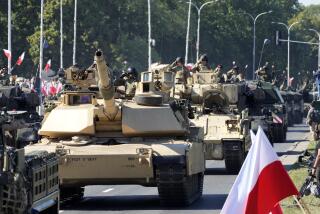Soviets Must Do More to Reach Arms Cut Goal, U.S. Says
- Share via
WASHINGTON — If the Soviet Union keeps President Mikhail S. Gorbachev’s promise to cut its military budget by 14.2%, it will have to go far beyond the economies it has already announced and cut deeply into research and development for future weapons systems, two U.S. intelligence agencies said Friday.
In a report to the congressional Joint Economic Committee, the CIA and the Defense Intelligence Agency estimated that the savings resulting from the withdrawal of Soviet troops from Afghanistan, compliance with the medium-range missile treaty and the troop cuts Gorbachev announced at the United Nations last December would account for less than half of the reductions needed to meet the 14.2% figure.
“We believe the Soviets will have to do much more than what they have publicly disclosed to achieve reductions amounting to 14.2%,” the report said. “Actions the Soviets might take to meet their promise . . . are likely to include reductions in military research, development, testing and evaluation.”
Such a scenario would eventually cut deeply into the Soviet Union’s armed strength. But the CIA-DIA report said there is no real way for the West to monitor reductions in research and development so it may be impossible to determine if Gorbachev keeps his pledge.
Regardless of Gorbachev’s talk of turning swords into plowshares, the CIA and DIA said, Moscow’s military spending increased last year at twice the pace of the economy as a whole, further shifting resources from civilian to military purposes.
Increased Military Spending
“We estimate that Soviet defense spending, as measured in constant 1982 rubles, grew by roughly 3%--in line with the growth rates of the past several years,” the report said. “Procurement of weapon systems was again a major contributor to growth.”
The continued military spending came against the background of a dismal performance by the civilian economy, mocking Gorbachev’s promised economic reforms, the report said.
“According to our estimates, after a spurt in 1986, the Soviet economy grew by about 1.5% in both 1987 and 1988, a rate reminiscent of the pre-Gorbachev ‘stagnation years,’ ” the report said, using Gorbachev’s pejorative term for the era when Leonid I. Brezhnev was in power in the Kremlin.
“The performance of most sectors of the economy was extremely discouraging to Soviet leaders,” the intelligence agencies said. “A disappointing harvest did much to slow the economy’s growth--farm production fell by an estimated 2%. . . . Our estimates indicate that industrial production increased by only 2% to 2.5% last year--not much better than the sluggish rates registered throughout most of this decade.”
The CIA-DIA report is closely watched because most of its basic economic statistics, routinely published in the West, are treated as state secrets in the Soviet Union.
For instance, the Soviet military budget has never been officially revealed, despite Gorbachev’s astonishingly precise promise to cut it by 14.2%. The Soviet leader made the pledge during a meeting with the Trilateral Commission, a non-government group of influential Americans, Europeans and Japanese, in January. This came about a month after he told the United Nations that Moscow would cut its military manpower by 500,000 and would demobilize 10,000 tanks, 8,500 artillery pieces and 800 aircraft.
The CIA-DIA report estimated the Soviet defense budget at 15% to 17% of the gross national product or between 110 billion and 125 billion rubles.
Unclear Points
“For all the Soviets’ show of openness on their defense spending plans, some crucial points about Gorbachev’s pledge remain unclear,” the intelligence agencies said. “Moscow has not, for example, indicated whether the promised 14.2% cut applies to 1988 spending levels or to the expenditures planned for 1989 and 1990. Similarly, it has not indicated whether the defense budget is to be reduced in real or only nominal terms--that is, whether the cuts will be made after or before the budget is corrected for inflation. Moreover, the Soviets have yet to reveal any figures on . . . their total defense spending.”
Turning to the civilian economy, the report said Gorbachev’s reform program seems to be foundering, in part because of increasing public grumbling about continuing shortages of consumer goods. Earlier this week, the Soviet government announced steps to alleviate some of the shortages.
“Consumers had little cause for satisfaction in 1988,” the CIA-DIA said. “Per capita consumption grew, according to our estimates, by only about 1.5% and would have been stagnant had consumption of state-produced alcohol continued to fall.”
More to Read
Sign up for Essential California
The most important California stories and recommendations in your inbox every morning.
You may occasionally receive promotional content from the Los Angeles Times.








